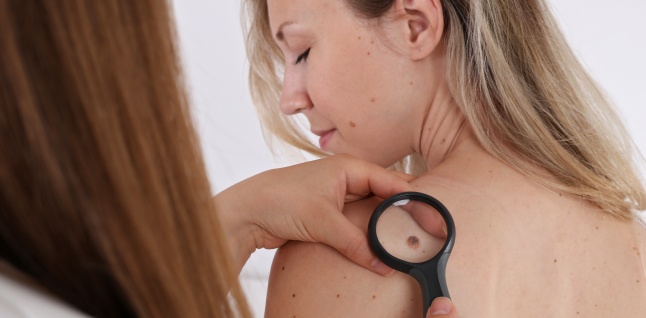Ignoring suspicious moieties can lead to cancer

Typical moles: - They have a uniform color, dark brown, tan, red, pink - Measure below 5 millimeters - They are round and have regular edges - They do not change their shape and color. Atypical moles: - They can form anywhere on the body, including the head, neck, scalp, trunk. They sometimes appear on the face - They may have a flat form or they may be in the form of an increase - They are larger than 5 millimeters - They have uneven edges - They contain two or more colors - Their surface can be smooth, durable . Permanent self-evaluation is indicated, following any changes in form, size and color. Check each part of the body, including the scalp, back of the arms, palms, soles, area between the toes and feet, the back of the neck, the area behind the knees and including the genital area and the buttocks. Keeps track of these moles, noting any new moles, but also any changes that occur.
Although most atypical moles do not turn into cancer, some of them may become carcinogenic. is a form of skin cancer that originates in pigment-producing cells, those that produce and the moles. The most important sign of melanoma alarm is to change the size, shape or color of a moon. The risk of being cancerous is 1 to 100, compared to 1 in 3. 000 typical moles that can turn into melanoma.
When do you go to a doctor? Any suspect modification of the moles should be checked by the dermatologist. Moles become suspicious when they get asymmetrical, they grow in size, their pigmentation becomes uneven and the edges become irregular. Changes such as motile height, swelling, burning sensations or burning at the level of the moon are signs of melanoma. The doctor will perform a biopsy that will be analyzed in the lab to determine whether or not it is cancer. Follow the changes - do a monthly self-evaluation, especially if there is a history of melanoma in the family.
Self-evaluation can be done with mirrors. Protect your skin - Take action to protect yourself from sunshine and UV sunshine at least 30. Avoid staying in the sun between 11 o'clock. 00 and 16. 00 - Schedule your outdoor activities for other hours of the day.
Avoid exposing the sun - it emit UV rays that can increase the risk of skin cancer. .
Source : sfatulmedicului.ro
Views : 3981
Popular Article
- (photo) Nude becomes art.
Posted: 2018-03-17, 9757 views.
- The harmful effects of air conditioning on the skin
Posted: 2017-06-08, 8463 views.
- 3 causes of dyed hair discoloration
Posted: 2017-06-15, 8344 views.
- Why early puberty occurs in girls: symptoms, favors, diagnosis and treatment
Posted: 2017-10-24, 8185 views.
- Good or bad skin treatments in the hot season
Posted: 2017-06-07, 7917 views.
Recommendations
- (photo) Nude becomes art.
Posted: 2018-03-17, 9757 views.
- The harmful effects of air conditioning on the skin
Posted: 2017-06-08, 8463 views.
- 3 causes of dyed hair discoloration
Posted: 2017-06-15, 8344 views.
- Good or bad skin treatments in the hot season
Posted: 2017-06-07, 7917 views.
- Risks of practicing sports on hot days
Posted: 2017-06-12, 7498 views.
 4 effective ingredients in the fight against acne.
4 effective ingredients in the fight against acne. How to get rid of hiccups fast
How to get rid of hiccups fast The wheat bran diet: the secret of lost pounds as if by magic
The wheat bran diet: the secret of lost pounds as if by magic The recipe that will sweeten your soul this weekend!
The recipe that will sweeten your soul this weekend!  Is it dangerous or not to refreeze meat after thawing it?
Is it dangerous or not to refreeze meat after thawing it?  The unusual sign of diabetes indicated by saliva.
The unusual sign of diabetes indicated by saliva. What to drink to boost your immune system.
What to drink to boost your immune system. 10 foods that help you never age.
10 foods that help you never age. What actually happens in your body if you drink a cup of coffee for breakfast
What actually happens in your body if you drink a cup of coffee for breakfast 5 surprising benefits of chia seeds
5 surprising benefits of chia seeds